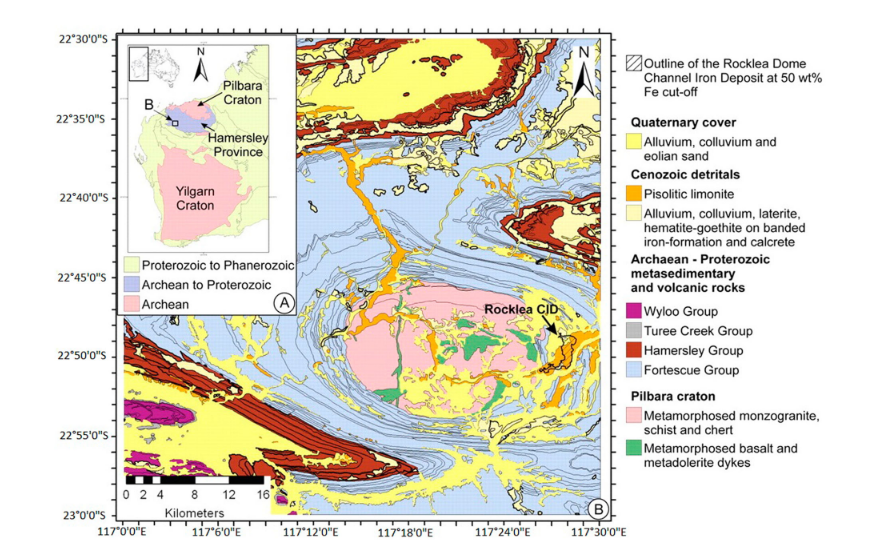History of the Rocklea Dome Formation#
Paleoarchean, + 2765 Ma#
The circular mass visible in the heart of the basin corresponds to the oldest part. It is mostly a monzogranite (equal proportions of plagioclase and orthose), cut by numerous mafic and pegamtic dykes. This massif, located at the base of our series corresponds to the Pilbara craton. It should be noted that this massif has been dated by the principle of superposition, and is most probably aged between 3.4 and 2.7 Gpa It is also remarkable that metamorphosed mafic sedimentary and volcanic rocks are visible within the formation, and corresponds to a “Greenstone Belt” type formation, characteristic of an oceanic extension resting on a basement, typical of the archeen, since the maturity of the tectonic plates leads to the dominance of the mechanisms of arcs and ophiolites during the Phanerozoic.
Archean, 2765 – 2687 Ma#
Above our basement is the FORTSCUE GROUP, resting unconformably. At depth this zone is divided into 4 formations: Maddina (0 to 500m), Tumbiana (500 to 700m, dominated by carbonates and stromatolite sandstones), Kylena (700 to 1000m, dominated by baslatic flows, pillow lavas and hyaloclastite, witnessing phreatomagmatism) and Hardey (1000 to 2100m, dominated by silicoclastic sand and conglomerates, showing conditions of fluvial deltaic fan deposit). All these formations are more or less associated with oceanic extension, but the most remarkable is the Hardey Formation, because its strength implies that it filled all available space as part of synrift sedimentation, and thus that the latter stopped at the Kylena Formation. The Hardey Formation is also interesting from a mining point of view because its detritic conglomeratic nature makes it rich in placer-type gold nuggets, the tonnage is therefore difficult to quantify, although exploration projects are underway. In addition, correlation of anomalous Cu alteration provides evidence of a potentially extensive stratiform copper mineral system associated with volcanic rocks between the volcanic rocks of the Kylena Formation and the siltstones and mudstones of the Tumbiana Formation. This would be one of the oldest known examples of this style of mineral system.
Late Archean – Paleoproterozoic#
In our series, the Hamersley Group, which contains most of the iron deposits mined in the area, lies conformably on the Fortscue Group. The lower part of the facies was deposited in the late Archean, and consists of alternating shales, iron oxide-filled beds, and volcaniclastic rocks. The upper part is what is commonly called a banded formation (or BIF), that is to say a regular and isopaque alternation of shales and iron deports, constituting the main source of iron mining in the world. The presence of iron and iron oxides reflects continental depositional conditions, confirming the theory that oceanic extension stopped at the Archean.
Paleogen (66 Ma – Today)#
Finally, in this area, a plaeochannel, very rich in iron and intersecting all the formations studied previously, has been extensively studied. This channel had its source in the Hamersley group, which explains the interest of the industry, because of its richness in iron. This formation is mainly characterized by an abundance of pisolite limonite (ooid greater than 2mm), organized in banks between 15 and 45m high. This facies contains a large number of different ferric detritus, goethite, hematite and iron oxides in general. The most likely hypothesis as to its formation is that pieces of detrital goethite and hematite were carried away by meteoric waters, served as nuclei, and were covered during their displacement by the natural precipitation of goethite, to form glassy cortex ooids. The rock is also cemented by geothite, younger than the elements, whose age varies according to the zone or one takes the rock, and the availability of water of the zone during the precipitation of the matrix.

